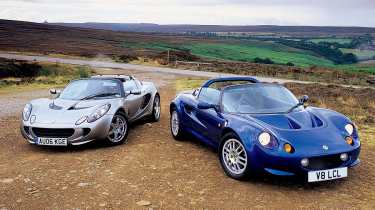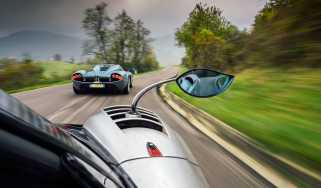Lotus S1 Elise v Lotus S2 Elise S: Light Years
With the arrival of the new 134bhp 'S', the Elise has gone back to basics. But how does it compare with the original of ten years ago?
Slightly grubby Blu-tac still clings to the original brochure where it was stuck to the wall next to my bunk bed at school. I was 14 when the Elise was launched ten years ago. Every magazine, leaflet, brochure and review was devoured with religious fervour and then filed for reference. I loved the Elise and everything that its minimalist philosophy embodied. At under £19,000 I could also say ‘one day’ and not feel like I was kidding myself completely. There’s nothing better than an attainable dream.
Over the intervening years I’ve managed to wangle rides in just about every Elise variant, including, bizarrely, a Sport 190 that belonged to my dentist (thank you, Mr Bourne). But apart from a miraculously blagged but very brief test drive of a then-new S2 at a dealer, I’ve never driven an Elise – until today.
With the launch of the back-to-basics, back-to-its-affordable-roots Elise S, we’re going to indulge in a bit of a tenth-anniversary celebration with an original S1. And where better to go than the roads of the North York Moors that saw the Elise crowned Performance Car of the Year 1996? Along for the minimalist ride are Brett Fraser (a man whose family call Lotus his first home and who was PC editor back in the day) and Kenny P (a considerably hairier co-photographer back in ’96 and described by Peter Tomalin thus: ‘His family’s from Poland, via Bolton, and his full surname sounds like a firework going off’).
More reviews
Group tests
In-depth reviews
Reviews
- Analogue Lotus Elise SuperSport review: the Elise perfected?
- Lotus Elise Cup 250 review
- Lotus Elise review – is the featherweight sports car as good as ever?
- Lotus Elise Sprint 220 review – is this the sweet spot in the Elise range?
- 2016 Lotus Elise Cup 250 review - the fastest Elise ever
- Lotus Elise S Cup review - prices, specs and 0-60 time
- Lotus Elise S Club Racer review, specs and performance
We rendezvous late on a Monday afternoon in a layby just off the A169 to Whitby. We were hoping to get some of the photography done today, but with rain sheeting down across the moors, things aren’t looking good. I’m sheltering in the Azure Blue S1 Elise while the raindrops drum repetitively on the canvas roof. It may be sparse, but there’s something of the exotic about an Elise. The view out over the wheelarches could be from any number of classic racers, from a 250LM to a Lotus 30, and the absence of anything superfluous to the driving experience gives just the same ambience you find in an F40 or F50.
Ambience isn’t the only thing you’d recognise from an F50, because the lovely little circular vents dotted around the base of the windscreen can also be found in Modena’s greatest supercar. Alright, so they might have appeared in the Alfa 33 first, and the indicator stalks may be from a Cavalier, but the extruded pedals, the simple, perfectly sized wheel and the long, chrome-topped gearstick are the focus. All three are beautiful to look at and work with, so it’s no wonder that what else there is fades into the background.
After half an hour, the brooding clouds show no sign of shrugging off the insistent rain, so we decide to abandon our layby and make for the pub where we’ll be staying for the night.
Next morning dawns with skies looking less menacing, so we head for the car park and begin disassembling roofs. Parked up next to the latest addition to the dynasty, the S1 Elise still holds its own. The single-piece, hand-laid clamshells give the original shape a cohesive, classic look that, in my opinion, the spiky, modern-looking new model can’t quite match.
Getting into an Elise is something best done after a lot of practice or out of view of other people, especially those likely to mock. The best way seems to be this: 1) grab something sturdy, such as the seat, 2) slide left leg in underneath steering wheel towards clutch pedal, 3) commence controlled fall, 4) halfway through said fall, swivel whilst lifting right leg over sill with minimal clearance, 5) landing gear down and extend right leg towards throttle, 6) close door nonchalantly.
Step 4 is the crux of the problem and could see you in need of a hip replacement, but it feels as satisfying as fourth-gear oversteer when you get it right. Then you have to try it with the roof on…
With the roads dry, I agree to meet the others later and take the S1 the long way back to our glamorous layby meeting point. The K-series in this car (kindly loaned to us by Heathcliffe Robertshaw, general manager for Lotus UK) has been given a K&N filter and a sports exhaust, so its 118bhp feel healthy and sound wonderful, but as we meander through the tight lanes that lead away from the pub, I quickly realise that you don’t need a huge wodge of power to push the Elise along. My original brochure claims a slightly optimistic 675kg, but the actual 731kg of the first car doesn’t exactly make it a sumo wrestler.
The gearshift, which has always come in for criticism, needs caressing between ratios, especially across the gate; meanwhile the suspension rattles and small stones occasionally ting up into the floor. But as soon as you touch the steering wheel there’s a synaptic connection with what’s running beneath the tyres. Ten years ago, Tomalin wrote ‘nothing else makes the same connection between driver and car and road’. That still applies today.
We turn off onto a faster road, and with more pace the Elise suddenly settles and focuses on the job ahead. With 185-section tyres on the front, the first-generation Elise was always over-tyred, but what you get as a result is absolutely unwavering turn-in. For a car that has been gliding along delicately, light on its feet, the sudden transition to vicious grip through a fast corner is breathtaking.
I’ve always been a fan of cars with pointy front ends, and the Elise feeds that craving. For the first few miles you feel like you’re not even beginning to stretch it. So you up your corner entry speeds until you feel the car really cut into the bitumen like a ski cutting through hard-packed snow.
Beware though, because that front end can catch you out. Not for the Elise the vagaries of a gentle wash wide when you commit too far. Almost as soon as the front end has slipped it will bite again and the rear is suddenly with you. If you haven’t dialled-in a quarter-turn then heaven help you. It’s edgy, to put it mildly.
So you pay it respect and concentrate on slicing cleanly through the corners, edging up to – and always aware of – its limit. But you click with the Elise, and because it responds so instantly and accurately, it’s almost as though it can read your mind. It’s like having a best friend who knows what your next sentence is going to be, or what you’re thinking when you see a shopping trolley and a hill.
The next few hours are spent jumping in and out of both cars, putting roofs up and down (‘Where’s the bloody Allen key?’) as the rain and occasional lightning (‘Kenny! Get the hell away from that tripod!’) sweep in and out. Ten years ago the PCOTY crew were fighting the cold by standing round a Lamborghini Diablo’s engine bay…
After lunch Kenny takes a break from snapping, so I seize the chance to snaffle a proper go in the new car. Get into the S (step 4 made easier thanks to slightly lower door sills) and the interior is familiar but slightly busier, with speakers in the sills and the odd cubby-hole here and there. You also seem to sit fractionally higher, although to be honest it’s worth it for the new ProBax seats, which retain the simply sculpted shape of the originals but manage to stave-off backache by a small miracle of minimalist padding.
The new engine from Toyota puts out 134bhp, which is near enough exactly the amount of our favourite S1 Elise, the Sport 135. It spins into life in a slightly characterless fashion, but the first click into gear with the ball-topped stick is a revelation of precision compared with the original.
The opening 3000rpm are compressed on the simple Stack rev-counter, suggesting it’s a place you don’t want to be, but there’s plenty of torque from about 2000rpm upwards. An added push comes at 4000, then a rorty note is added from the exhaust at 5000rpm. But the beauty is that, unlike with many more-powerful Elises, you don’t feel the need to continually batter the last few thousand revs up to the red line. The engine feels perfectly matched to the five ratios and you can’t honestly think why you’d want more power on the road – 5.8sec to sixty isn’t exactly shabby.
Back on the fast, flowing road from the morning, the S’s steering seems lighter, possibly thanks to narrower 175 Yokohamas at the front. There’s also more progressive but less attention-grabbing turn-in. Initially it feels like the Elise has lost some of its soul, but you soon realise that it’s actually allowing you to expose more of its abilities. Now, instead of nervously feeling the outer reaches of the chassis’ grip, you can really push the car into and through a corner. When grip ebbs away at the front you have options: lift a fraction with your right foot and the S will return to a neutral stance; keep it pinned and, as grip returns to the front, so the back will ease round and help you through. Once again, words written a decade ago, this time by Dickie Meaden, ring in my head: ‘The only way to get an Elise-like experience is to drive an Elise. Nothing else comes close’.
At the end of the day, once the firework from Bolton has packed his lenses away in our Skoda Octavia long-termer, Kenny and Brett set off in convoy for the A1. But I’ve got one last thing to do before I leave the moors. While preparing for this trip back in the office, sub ed Ian Eveleigh pointed out an inconspicuous-looking road on the atlas that I’m determined to find. I loop round south, briefly leaving the moors to brim the tank of the S before heading back in once I’ve found the right signpost. The first couple of miles of road climb up through trees to a small, stony village. Through this, clatter across a cattle grid, blip and snick a lower gear to pass a farmer’s Isuzu Trooper, and then the Elise and I are released into some sort of motoring nirvana.
The world seems to peel away either side as though I’ve been released from tunnel vision. The road twists away into the distance along the spine of a ridge, and the evening sun is sending great shafts of light down through the breaks in the clouds, glistening off the few remaining patches of damp on the tarmac. The road bucks, tightens and crests through the sheep and heather, and the Elise is in its element. Skimming lightly across the surface yet always in intimate contact, at speed the little Lotus deals sublimely with unruly black-top.
Fourth gear is perfect for this road, revs frequently hovering around that subtle 5000rpm note-change, but always delivering enough punch should you dip below it. Occasionally you change gear just for the hell of it, but usually you simply immerse yourself in what that aluminium tub is telling you, soaking up the flood of information like a sponge, the tiny three-spoke steering wheel with that magic green and yellow roundel forever dancing in your hands.
The road seems like it will never end, but after twelve and a half miles the jangle of a cattle-grid signals the approach of the other bookending village. So I turn round.
This time I up the bravery stakes, going harder at the corners, leaning further into the limits of the chassis’ grip. There isn’t another person for miles and I’m picking the best lines I can muster. Feel the front bite, lean into the sidewalls, feel the front edge away a fraction, hold the throttle, trust the rear… There’s the grip. Nail the exit and settle yourself for the next corner emerging rapidly out of the low evening sun. When you get it right, everything’s a mixture of hardcore grip and wonderful fluidity.
Eventually, tingling and goosebumped, I drift back into the first village, let the clutch out and roll to a stop next to the village green. As the cooling metal tings away, I seriously consider turning around for another run. It might be ten years since I first Blu-tacked that brochure to my wall, but it was worth the wait.
Comparison
| S1 Elise | S2 Elise S | |
| Engine | In-line 4-cyl | In-line 4-cyl |
| Location | Mid, transverse | Mid, transverse |
| Displacement | 1796cc | 1794cc |
| Bore x stroke | 80 x 89.3mm | 79 x 91.5mm |
| Cylinder block | Aluminium alloy | Aluminium alloy |
| Cylinder head | Aluminium alloy, dohc, four valves per cylinder | Aluminium alloy, dohc, four valves per cylinder, VVT-i |
| Fuel and ignition | Electronic engine management, sequential multipoint injection | Electronic engine management, sequential multipoint injection |
| Max power | 118bhp @ 5500rpm | 134bhp @ 6200rpm |
| Max torque | 122lb ft @ 3000rpm | 127lb ft @ 4200rpm |
| Transmission | Five-speed manual, rear-wheel drive | Five-speed manual, rear-wheel drive, TCS optional |
| Front suspension | Double wishbones, coil springs, gas dampers, anti-roll bar | Double wishbones, coil springs, gas dampers, anti-roll bar |
| Rear suspension | Double wishbones, coil springs, gas dampers, anti-roll bar | Double wishbones, coil springs, gas dampers, anti-roll bar |
| Brakes | Ventilated discs, 282mm front and rear | Ventilated and cross-drilled discs, 282mm front and rear, ABS |
| Weight (kerb) | 731kg | 860kg |
| Power-to-weight | 164bhp/ton | 158bhp/ton |
| 0-60mph | 6.1sec (claimed) | 5.8sec (claimed) |
| Max speed | 126mph (claimed) | 127mph (claimed) |
| Basic price | £18,990 (1996) | £23,995 |




